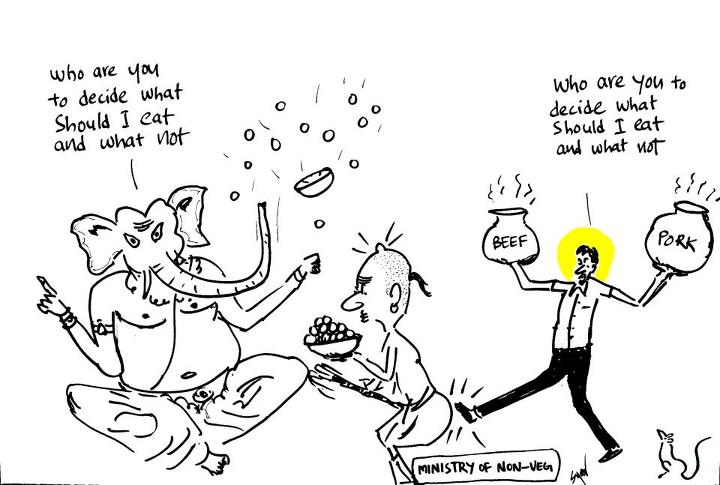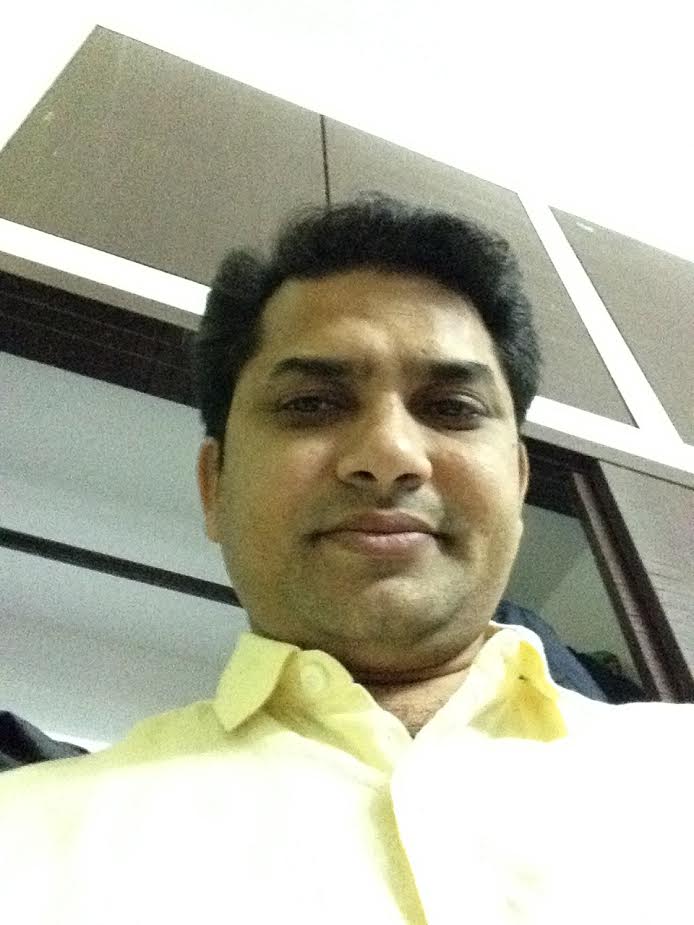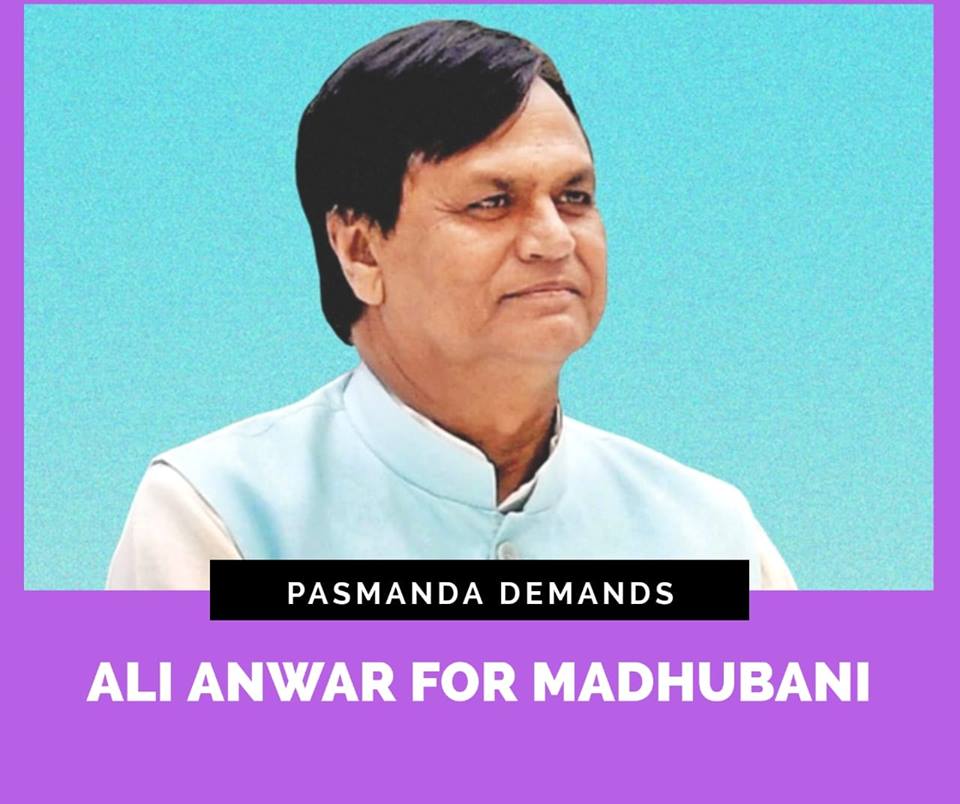Ravi Chandran
When its udders were squeezed and milked
You didn’t feel any pain at all
When it was stitched into a chappal you stamped underfoot and walked
You didn’t feel hurt at all
When it rang as a drum at your marriage and your funeral
You didn’t suffer any blows
When it sated my hunger, beef became your goddess?
~
[From a translation of the Telugu poem ‘Goddu maamsam’ by Digumarthi Suresh Kumar. You can find the full translation on ‘The Shared Mirror’ here]
~~
Time and again India has showed its Hindutva[1] character. The recent ‘banning’ of the ‘Beef and Pork festival’ in JNU and the missing voice of protest only adds opium to Hindutva. Even those students who speak against the state seem to have smelled this opium and are never in their conscious state. One of the sad points I wanted to address in this article is how some Dalits were not discussing all the issues involved in beef and pork consumption. When Osmania University students organized the Beef festival, everyone including ‘left liberals’ and others predicted ABVP will ask for Pork. ABVP did ask for pork to be served; when JNU students came forward to do a similar event then suddenly the left liberals are talking about Pork, in the context of Muslims. Hence I don’t know how to differentiate ABVP and left liberals/democrats, like the DSU in JNU who argued along these lines:
..There has been no single instance where any Muslim organization has forcefully intervened to stop consumption of pork by any community or individuals…..
And not surprisingly caste never appeared in their opposition to this festival. Also their stance seems to be very contradictory: they express support for the north eastern students’ demand but oppose beef and pork festival. It is this deep ignorance of Hindutva politics in India which shows the hollowness of their liberal democratic politics.

It’s a dangerous argument in which Muslims are drawn into the discussion and the Dalits’ questions are marginalized. It’s dangerous because it plays along with the agenda the Hindutva wants to construct.
Hence I am writing this to put a few thoughts down clearly. At the outset, I want to ask: “Your Hurt Sentiments on Beef and Pork, My Foot!“.
The two meats are also the pillars on which Hindutva has built its politics since its inauguration through the Arya Samaj. The two animals when alive denote the contradictions between the ‘pure’ and the ‘impure’; after their death both, beef and pork, are filth for Hindutva. The cow is considered as holy, but it’s filthy after its death, which is unique to India.
Pigs and pork: Filthy when alive and ever after
The pig is associated with filth, hence considered a filthy animal while alive and after death too.
If there is one single population in India for whom eating beef[2] and pork had the deepest socio-cultural implications, it’s the Dalits. These populations have been humiliated, historically, for eating those two kinds of meat.
Om Prakash Valmiki writes in Joothan:
Pigs were a very important part of our lives. In sickness or in health, in life or in death, in wedding ceremonies, pigs played an important role in all of them. Even our religious ceremonies were incomplete without the pigs. The pigs rooting in the compound were not the symbols of dirt to us but of prosperity and so they are today. Yes, the educated among us, who are still very minute in percentage, have separated themselves from these conventions. It is not because of a reformist perspective but because of their inferiority complex that they have done so. The educated ones suffer more from this inferiority complex that is caused by social pressures. P 13
In school he used to be humiliated for eating pork ..’Abey, Chuhre ke, you eat pork.’ At such moments, I would think of all the Tyagis (Upper Caste) who came in the darkness of the night to the Bhangi basti to eat pork. I felt like calling out the names of all those people. Those who came to eat meat secretly at night in daylight observed untouchability in front of everybody.[3]
However the ‘sentiments’ of these non-Muslim communities, with regard to pork, never appear salient in mainstream discourse, which always seems to associate antipathy towards pork with Muslims, as a result of a deliberate propaganda Hindutva forces had spread over the past century.
Making of the Un-holiness of Beef
Beef in India is eaten at least by 80% of Indian population: they include Dalits, Adivasis, Bahujans, Minorities, of course Brahmins in US, UK etc. However, none of the categories is homogeneous in their consumption patterns. But still we could say a large proportion of the population eats beef and pork. Among Dalits there is a sub-caste who are involved in tanning and leather working; they eat beef and their main occupation is making goods of leather. In many parts of the country, they also eat pork.
In the cities there was a demand for leather shoes, saddles and artillery for the generals and rajahs. In the countryside, it had a variety of uses like irrigation bags, belts and harness for cattle, besides containers for transporting ghee and water.[4]
This population purely depended upon their natural, traditional ways of tanning leather, but after the advent of innovation in the form of machines, the rapid growth of the leather industry led them to quit the occupation. But eating beef continued.
Responses to such public ‘festivals’
Beef festivals have received mixed responses. Dalits would say that it’s only because of eating beef they became untouchables. Muslims are very much ‘worried’ that if beef is brought to a public platform they would be unnecessarily targeted by Hindutva politics, which has historically made them out to be the only people who eat beef. On beef and pork politics in India, we have literature only on beef. Hindutva politics has been harping since the end of nineteenth century that cow is holy, and Ambedkar’s volume on why broken men became untouchables explains the historical context of how untouchables were made. The recent book ‘Myth of the holy cow’ talks about different religious traditions and the habits of eating beef and pork. Therefore one thing is very clear, that since ancient times, beef and pork were part of Indian cuisine.
Pork seems to have been a favourite; roast pig was therefore offered to guests at weddings.[5]
Putting aside historical writing for a moment, let us look into the process of the making of the Hindu nation till now, only to substantiate the arguments the books have already made.
I would like to look at the two stands, for and against Beef and Pork in JNU for analysis.
Within Dalits there is one argument that we should leave beef and pork eating habits. Others say that if you want to eat, then go ahead and eat but don’t make an issue of demanding it in public places[6]. I see both these arguments as being against the demand for beef and pork in public places.
Yet others say that: we will assert our right to eat it. These arguments have to be seen in the historical context which the Dalit movement underwent.
In an historical reading, Dr. Ambedkar said:
“…in the ancient past when both the Settled Community and Broken Men did eat beef the former ate fresh beef and the latter of the dead cow.”
In short, in ancient times Brahmins used to eat beef, and to forge a different identity they became vegetarians, while other upper castes continued eating beef. Eating beef was a costly affair then. Dalits were also eating beef but ate the dead cow’s meat because most of them were involved in leather work. Dalits were seen as low by the non-Dalit population. When Dalits started to eat fresh meat, the savarnas shifted to mutton. But still the savarnas look down upon non-Muslims (Dalits) who eat beef. And pork has also been considered as an untouchable food, as we saw in Omprakash Valmiki’s narration.
This notion of inferiority (associated with beef and pork consumption) still continues as we saw above. I do remember many members[7] of my own community who live in non-Dalit neighbourhoods don’t even admit that they eat beef or pork. Many of them, while buying beef would wrap the meat as chicken is wrapped. Many don’t even prefer to buy pork, but it’s a main food during festivals of Arunthathiyar gods. With the prevalent notion of inferiority attached to both kinds of meat, the educated middle class among Dalits have largely avoided beef completely.
We should also keep in mind that the making of beef as an untouchable food accompanied the making of ‘Hindu/Indian Nationalism’. It was during the period of the rise of nationalism that the Arya Samaj along with Gandhi made inroads into Dalit villages and campaigned on the same. Now let us look into this aspect.
Before going into further reading we should understand that the entire project of converting the holy cow into filthy beef was not a simple task for Hindutva. However pig, with its association with filth, was naturally easy to be termed as unholy, hence there was not much discussion on that. But pork got its significance, as I see, only because of the reference to it in the holy book of Quran terming pork consumption as a sin; but the book never said that others should not eat pork or that others eating it will harm Muslims.
The first historical attempt to bring pork into mainstream discourse or associate it with Muslims can be traced to the 1857 Sepoy Mutiny. After that, it’s only recently that we hear more about it in the news. It is only through this negative association with the Muslim community that pork has gained its political significance, and has now grown, dangerously, to its peak.
Both these kinds of meat have not acquired any significant attention in the context of the way they were associated with the creation of notion of ‘untouchablity’. As a result, when Dalits talk of beef, the Hindutva elements take up pork, indirectly pointing fingers at the Muslim population. To bring in the Cow Protection Act they cunningly implicated the Muslim population, and now when we bring up beef, again the issue of pork crops up, targeting Muslims. Therefore it’s important to see, historically, the way beef was disassociated from the Dalits.
Hindutva Nationalism
At this juncture it’s useful to recall what G.Aloysius wrote about Indian Nationalism: .
“..as Nationalism arose during the last quarter of the nineteenth century at the breakup of the Brahmanical order, the Gandhian critique of civil society during the first and second quarter of the twentieth century was intended to re-establish the same old order…” P213[8]
It is in this context that one has to see M.K.Gandhi’s confidential note to his associates, after the declaration of the Communal Award in 1932, expressing the worry that if Dalits did not fall into the camp of the Hindu it will ‘lead to bloodshed. Untouchable hooligans will make common cause with Muslim hooligans and kill caste Hindus‘[9].
However in the early twentieth century, Hindus did not show any interest in their fraternal ties with Dalits[10]. But later, as Gandhi’s view was propagated by many Hindu preachers who travelled to the countryside and offered many incentives to Dalit-Bahujans etc if they joined the Hindus and transformed their social customs. In this process they also started sowing hatred against Muslims among the Dalit communities, especially amongst those indulging in the scavenging occupation. Here is an example of the devices used to accomplish that:
The militant Hindu narratives simply inserted Muslims into the tale, so that the act of misfortune is the war with Muslims after which, one Gandhian wrote, ‘defeated persons were forced into this work [sweeping] and their respect was taken from them[11].
There were many such campaigns against Muslims; one of the most important among them was a particular legend militant Hindus used which says that it is due to the Muslims that the scavenging occupation was started:
There were no sweepers before. They came into existence when the Muslims entered this land. As Muslim women observed seclusion, the Muslims needed sweepers. Therefore, they made others into sweepers. Many of them were Brahmins originally. Some were Rajputs and there were men of other castes. It is obvious that the Muslims forced them to become Sweepers and to do such menial work. Now it is the duty of the Hindus to uplift them and to include them in other castes[12].
Such malicious narratives are still popular among our bureaucrats– check the book “Squatting with Dignity: Lessons from India”. Also illustrative is this passage from Bindeshwar Pathak’s ‘Road to Freedom’:
…the existence of Purdah system in medieval period had led to expansion of scavenging system in India. During this period, the Muslim women used to wear burqa (veil) to cover their faces and they were not allowed to defecate in open. So they preferred to defecate at home in Purdah and the bucket privies were, therefore, designed and constructed for their defecation (Pathak, 1991).
With all these campaigns Gandhi did succeed in bringing a good number of Dalits into the fold of Arya Samaj, who constantly harped on abjuring beef and also making Muslims as the enemy. This process had the purpose of constructing a notion that beef is related to only Muslims. Since the Dalits were a meat eating population, the militant Hindus succeeded in projecting Muslims as the only beef eaters, to mark them from others. However, the position of Hindutva is not clear on Beef, while it portrays the cow as holy, it has not said anything about beef, apart from saying it hurts ‘Hindu’ sentiments.
At this point I would like to recall one recent incident: a few years ago, when EFLU students organized a beef eating event in the University Mess, the Hindutva students threw down the cooking vessels, vandalized the mess. They peed on the beef and threw the cooked beef across the hostel wings. This shows that Hindutva considers only the cow as holy and beef is mere filth.
It is only in this country we could have such a contradictory set of beliefs, where cow is considered holy, its milk, ghee, etc everything is holy; now the Cow Protection society says even its urine is holy but its meat is filthy. This argument doesn’t even have logic.
To be continued.
~~
References
[1] In this article I associate Hindutva with everyone who opposes beef and pork, Hindutva is a set of notions, no one needs to be part of RSS, VHP, etc to subscribe to them. For at least a century the Hindutva parties Arya Samaj etc have been imposing their ideas in all walks of life. Anyone, even Dalits, Muslims, and Christians, could be subscribing to some of these ideas.
[2] When did Broken men become Untouchables, Dr. Ambedkar.
[3] Om Prakash Valmki, Joothan.
[4] Read EPW November 23, 2002, V. Sujatha, “Leather Processing: Role of Indigenous Technology“
[5] Jha.D.N, “The Myth of Holy Cow” Navayana 2001, p65
[6] For the sake of this article, I term University spaces run by the state as public spaces.
[7] Arunthathiyars, who do scavenging and leather working in Tamil Nadu.
[8] Aloysius G, “Nationalism without a Nation in India” OUP Delhi, 2011
[9] Note of 21 August 1932, Collected Works of Mahatma Gandhi, New Delhi: GOI, 1958 onwards), Vol.50,p.469.
[10] P.80, Prasad Vijay, “Untouchable Freedom: A Social History of a Dalit Community” OUP Delhi, 2000
[11] Ibid 79
[12] Tej, 5 May 1924 and Vijay Prashad, ‘The Untouchable Question‘, EPW Vol. 31, no. 9, 2 March 1996, pp. 555-6
~~~
Cartoon by Unnamati Syama Sundar.










